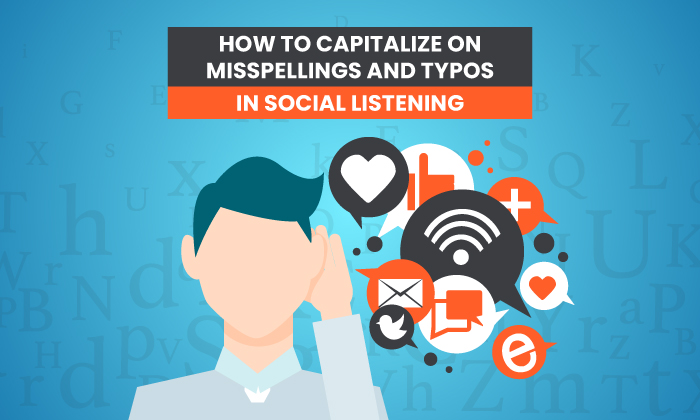
I’ll let you in on a secret.
People are talking about you online. Whether it’s a direct @ mention on social media or involvement in an untagged rant—the likelihood is, there’s a lot of conversations occurring on “dark social” that you don’t know about.
For the most part, brand mentions are a marketing score (even when the words themselves are negative). It means your brand’s reach is growing, you’re developing a presence, and people are using your products or services.
Typically, social listening helps you stay on top of all the gossip, gauge brand sentiment, and have engaging conversations with your audience. However, you are bound to find that some people will misspell your brand name or other important keywords and hashtags you’re looking out for.
How do you catch all the praise, complaints, and potential new business if someone’s clumsy thumb gets in the way?
By monitoring misspellings and typos.
It’s a super-sleuth approach to stay on top of all your mentions, develop a robust social listening strategy, and inform business decisions. Not only will you find new leads that are valuable to your marketing efforts, but there is a ton of other benefits to improving your awareness online.
What Is Social Listening?
Social listening involves tracking brand and competitor mentions alongside industry conversations on social media. It helps you listen in on what people are saying online and gives your brand opportunities to act on positive or negative sentiments.
“But isn’t that run-of-the-mill social media monitoring?” you ask.
Nope.
While the two concepts are similar, there are some key differences.
Social monitoring is about collecting data like brand mentions, relevant hashtags, and industry trends. You would typically use this information for monitoring your ROI on social media campaigns or A/B testing. There is no direct engagement with your audience.
Social listening is when you take action with the data and add a human element to your business front by responding to conversations.
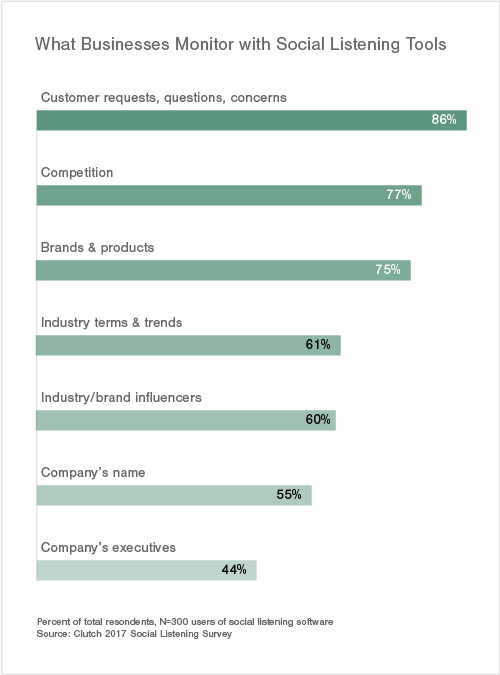
Why Should Brands Care About Misspellings and Typos in Social Listening?
OK, so why are misspellings important to your business?
Consider your own thumbs.
Sometimes when you’re in a rush, you might accidentally bash the wrong letter on your keyboard, or your smartphone might autocorrect your spelling without you realizing it, causing unintentional high jinks and drama.
It’s something so common that there are dozens of articles tracking the biggest autocorrect fails of all time.
Who’s to say the same thing isn’t happening to your brand or competitors?
If your company name (or other related terms) are misspelled, it is harder for your team to monitor social media mentions. You could miss out on potentially making a sale or stopping customer dissatisfaction by not covering all your bases.
Here are a few benefits of monitoring misspellings and typos of your brand’s name:
- Find more conversations about your company and manage crises: If a person says something negative about your brand on Twitter and uses the wrong spelling of your brand name, then your research provides you with a perfect opportunity to engage with them and try to fix the problem.
- Track competitors: If your competitor’s brand name is misspelled or has a typo in their brand name, you can find these conversations and start tracking them.
- Discover industry pain points: Monitoring misspellings around topics in your industry is a gold mine. You’ll get a ton of insight into what is and isn’t working and use the information to create a new product or improve your marketing strategy.
- Find new leads: If someone is venting about a competitor or complaining about a problem you solve but has a common typo or abbreviation in their Tweet that you’re monitoring, you can swoop in, start a conversation and potentially make a sale.
All of this data and its benefits wouldn’t even be on your radar if you only stuck to monitoring the correct spelling—imagine missing out on hundreds of potential leads every year.
Tips to Capitalize on Misspellings and Typos in Social Listening
Ready to turn those typos into profit? Follow these tips to stay on top of misspellings and reply to users as soon as the mention happens.
1. Use Ubersuggest to Gauge Typo Volumes
Ubersuggest is my personal keyword research tool which can double as a social listening research tool.
You can use it to see how many people are misspelling your brand name or a phrase every month. This can give you an idea of which words you want to monitor.
For example, a common misspelling of my name is “Neil Petal.” According to Ubersuggest, that search term gets 14k hits a month. That tells me it’s a lucrative typo to monitor with a social listening tool. That’s 14,000 new leads, conversations waiting to be had, or traffic that I could redirect to my website.

Another good example is Canon. A typo for the brand “cannon camera” gets 165k searches per month. If we head on over to Twitter, we can see that the misspelling is popular there, with hundreds of Tweets mentioning “cannon” instead of “Canon.”

As you can see below, a lot of the conversations referring to “cannon cameras” are potential business opportunities for Canon.
Canon could solve one Twitter user’s problems by writing a blog comparing their m50-mr2 to the Sony a6400 for vlogging, or they could increase their chances of a sale by directing @Neccy_Pooh to their favorite lens comparison lists, published by popular reviewers like DigitalCameraWorld, Shotkit, and PCMag.
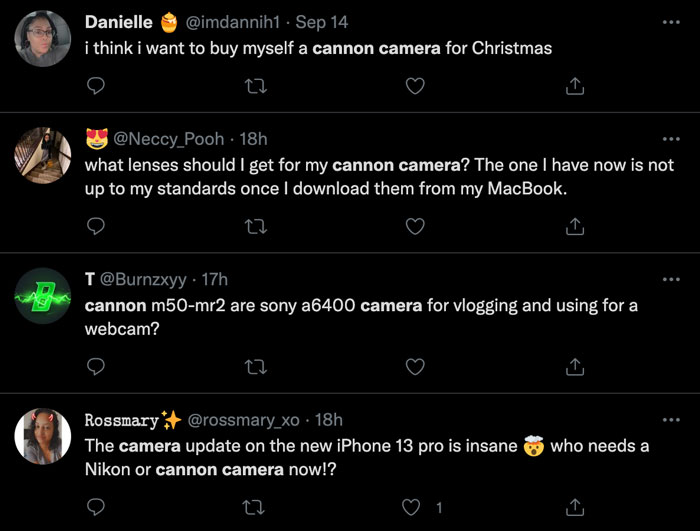
2. Set Up Google Alerts for Keywords With Typos
Once you’ve set up a social listening tool, it’s time to create Google Alerts.
Over the years, I’ve used it to build backlinks and carry out PPC research, but it doubles as a way to monitor brand mentions as well.
What are Google Alerts? It’s essentially a notification tool that will send you an email every time a specific word or phrase you’re watching is used.
The tool lets you monitor sources like:
- blogs
- news
- web
- video
- discussions
Only operating in a specific location or use a word that means something else in another language? You can further filter results for a particular country to make sure you’re only getting pings for the most relevant results.
Some of the typos you’ll want to monitor include:
- your brand name
- domain names
- product names
- industry terms
- your email address
How to Set Up Google Alerts for Social Listening
Step 1: Sign in to your Google Account and go to google.com/alerts. You’ll see a screen that looks like this.
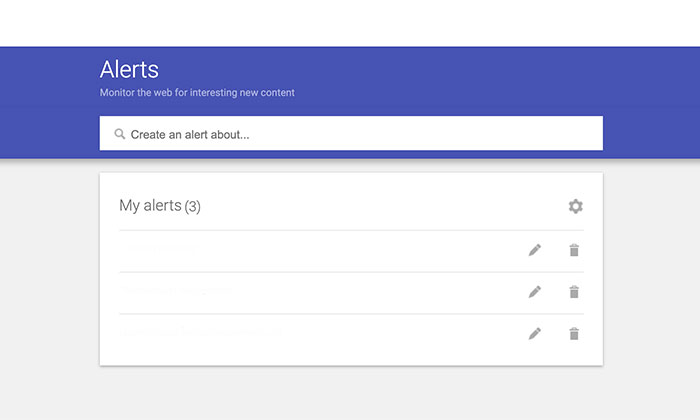
Step 2: Enter the misspelled word you phrase you want to monitor in the search bar.

Step 3: Click on show options to fine-tune your results. These are the settings that I recommend you use:
- How often: At most once a day.
- Sources: Blogs, Web (and any others that are relevant to you).
- Language: Choose the language you are targeting.
- Region: Any region (unless your audience is region-specific).
- How many: All results.
- Deliver to: Enter your email address.
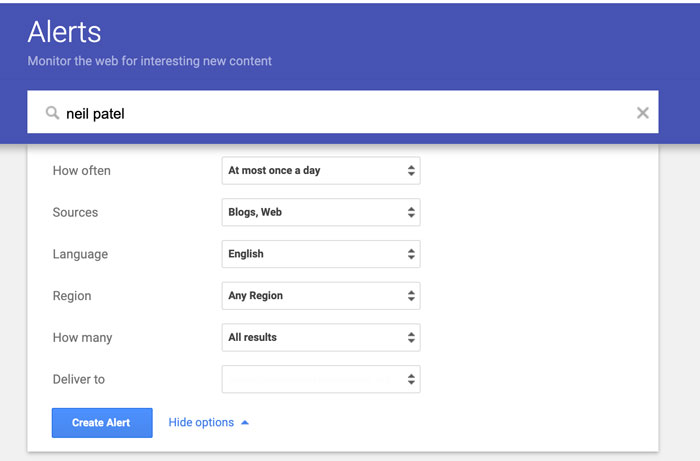
When creating your Google Alerts, use quotation marks around phrases for example, “digital marketing.” It will return results with an exact match for your brand name or industry keywords.
This is one way to make sure you don’t miss out on any opportunities and are able to respond without missing a beat.
3. Monitor Common Misspellings of Your Competitors
Keeping an eye on your competition is an important part of any social media strategy. By keeping tabs on what they are up to, you can quickly adjust your marketing efforts and respond to any trends. Monitoring the misspellings of their brand mentions and keywords helps you understand their audience and start conversations which could lead to onboarding a new customer.
The business opportunities don’t end there.
Listening to your competitor’s mentions helps you discover key customer insights.
- Are people requesting a feature?
- Do they hate a particular design feature?
- Is there something your competitor is doing that you don’t?
You can use these mentions as clues to adapt your business and give your competition a run for their money.
4. Track Common AutoCorrect Misspellings and Website Mentions
As mentioned earlier, autocorrect is a blessing but also a curse at the same time. If you have a brand name like “Readr,” it will most likely change it to “Reader.”
Research your common misspellings and add them to your list of words and phrases to monitor.
Lastly, don’t forget about brand domain mentions. Include misspellings for your domain and include results for with and without the “www” for example, reader.com, and www.reader.com.
5. Keep an Eye on Branded Hashtag Typos
One of the best misspellings to monitor on social media is hashtag typos. Customers who are over-excited to write something online (or just plain angry) might let their clumsy thumbs get in the way. Combined with general bad spelling, you may miss an opportunity to turn a customers’ mindset around and solve their problems before it is too late and they have already requested a refund or left a bad review.
If you don’t already have one, create a running list of hashtags to monitor. You can then start your search by hopping onto Instagram and typing in different ways to misspell your brand name and branded hashtags.
For example, the camera brand Nikon has 197,423 Instagram posts using the misspelled hashtag #Nikkon. Their branded hashtag #NikonNoFilter has 300 posts using the typo #NikkonNoFilter as well.

How to Monitor Misspellings and Typos in Social Listening
The best way to monitor branded spelling mistakes on social media is with a social listening tool. These tools help you instantly find and monitor conversations about your brand online.
Instead of manually entering a keyword across multiple platforms, listening tools streamline the entire process, saving you time and keeping track of opportunities to engage with your audience.
One of the best-rated tools is Brand24, due to its wide range of features.
Simply enter in the keywords and hashtags you want to monitor, and you’ll get daily reports on brand sentiment, popular hashtags your audience is using, words that are used most frequently with your keywords, and you can track anywhere from 5,000 to 250,000 mentions per month.
Once you have your daily report, your social media marketing team can go in and start meaningful conversations with raving fans, disgruntled customers, and potential leads.
It’s the easiest way to manage your online reputation and grow your business at the same time.
If Brand24 isn’t in your price range or doesn’t have all the bells and whistles you’re looking for, some other social listening tools worth checking out are:
- Mention: Enables you to listen to your mentions across the web and social media. Monitor over one billion sources like review sites, and forums as well as conversations on Facebook, Twitter, and Instagram. You can publish your responses without having to leave the application, streamlining the entire process.
- Hootsuite Stream: This feature from Hootsuite is a built-in feed that monitors activity across all your social media accounts. You can use it to track keywords, competitors, and hashtags.
- Keyhole: Helps you shave off hours from your workweek by helping you automatically monitor conversations about your brand and competitor. It has a suite of other features including influencer tracking, social publishing, and campaign tracking.
Social Listening Frequently Asked Questions
What Are Some Social Listening Strategies?
Some of the top social listening strategies include monitoring misspellings and typos of brand names and hashtags, identifying influencers promoting your business, monitoring competitor content, and keeping tabs on industry trends.
How Is Social Listening Measured?
You can measure social listening by tracking the number of mentions of your brand. Looking at the sentiment or tone of the conversation helps you measure if people feel positive or negative towards your brand.
What Is Social Listening Used For?
Social listening is used for online reputation management and identifying ways to start meaningful conversations with customers or potential customers. It’s also used for keeping tabs on your competition and how their audience feels about them.
How Does Social Listening Work?
Social listening helps you monitor conversations happening on any particular platform so that you know what people are talking about when they mention your brand. Keep an eye on what’s happening in your industry and capitalize on any opportunity for new business.
Misspellings and Typos in Social Listening Conclusion
In conclusion, misspellings and typos can be a gold mine for your social media marketing team.
To capitalize on these mistakes, make sure you’re tracking them with a social listening tool to see what people are saying about your brand online. Use this feedback as an opportunity to start conversations, increase engagement, and improve online sentiment about your brand.
How has social listening helped you grow your business online?
from Blog – Neil Patel https://ift.tt/3zYyub0

No comments:
Post a Comment